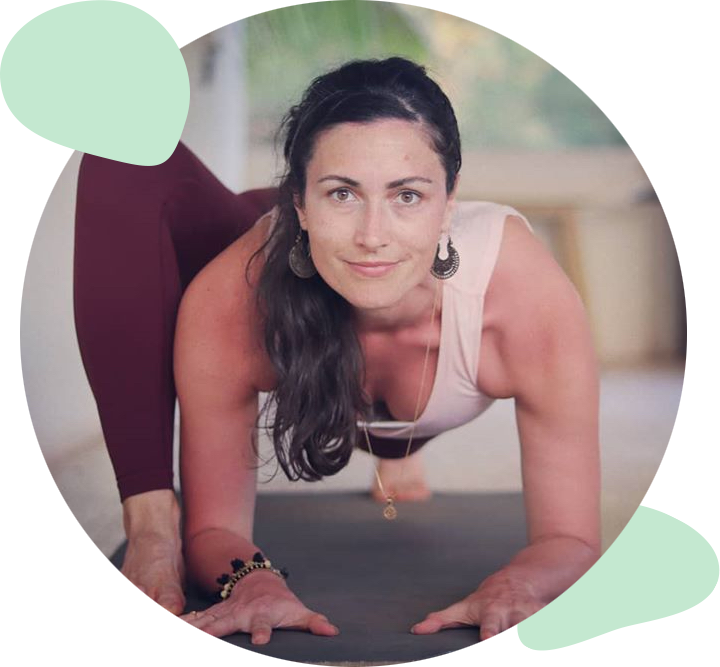Props: why and how to use them
I’ve been wanting to write an article about my favourite props for a while, mainly because I think that props overall don’t get the recognition they deserve. For a long time, I wasn’t keen on using them as I perceived it as failing. “That’s because I’m not able to do this asana that I need to “cheat” to get there”. In a nutshell, I thought that it was some sort of weakness to need help or assistance. That’s crazy how your ego can take over common sense sometimes!
I consider myself fairly flexible and overall quite fit, however some postures are still very hard for me to achieve (and by this I mean, be comfortable enough in the posture to be able to breathe properly). Some are scary; using props to assist with these scary postures allows you to experience what the posture feels like but still know you’re supported. Eventually, that feeling of fear goes away. Props allow you to learn more quickly, or to feel supported when it feels necessary. And sometimes it’s necessary depending on the posture, sometimes it’s necessary depending on days. We aren’t like machines, we can’t expect our bodies to be capable of the same things every single day, despite fatigue, stress or age.
It took me several years of practice to start unlearning this and think differently - having been raised in a typical French manner, we’re very bad at dealing with failure, as we never see it as part of the process neither a way of learning and move forward - and to accept the fact that practicing yoga doesn’t mean trying to be bendy at any cost. This practice aims at creating space in our body, balance and therefore internal peace. Whether or not you use props. If props can help you create more space and better balance then bless them! Those props are kind - but our ego is quite often judgmental.
Blocs
I like using blocs in revolved type of postures such as parivrrta trikonasana (revolved triangle pose) or parivrtta ardha chandrasana (revolved half moon balance). I’ve always struggled to keep my hips squared so using a bloc in these challenging postures allows me to focus on my hips.
Parivrrta trikonasana: modification with a bloc
- From tadasana (mountain pose), take a long step back with your left leg (to start with).
- Turn your back foot so that it creates a 45 degrees angle with the alignement of your right foot facing forward.
- Legs are straight, hips are squared (aligned with the top of the mat).
- Drop your bloc on the right side of your right foot.
- On an inhale, fold forward but keep your spine straight. The front and back of your spine should be the same length (no rounding of the back).
- On an exhale, start rotating your torso toward the right side and put your right hand on your sacrum. This is to make sure your hips will remain square (your hand should always be flat).
- Put your left hand on the bloc; your left arm is straight.
- Push on the bloc with your left hand in order to turn toward your right a bit more. Your shoulder girdle should be on the same plane (sagittal plane).
With every inhale elongate your spine toward the front, create space in between each vertebrae.With every exhale, rotate deeper by pushing onto the bloc.
Straps
I’m hyper mobile from a few areas but if there’s one area which has always been very tight, it’s my hamstrings. Before I started yoga I couldn’t keep my legs straight in dandasana! Using a strap helped me a lot with stretching my back legs muscles as it gave me a few more centimetres to have a grip. Eventually I managed to reach my toes without a strap, but it took me about 2 years to get there.
Dharma wheel
I’ve only just started playing with this one. I saw a few people using it on instagram, especially for backbends. Last week I attended a Dharma wheel class where we’ve been taught how to use this prop to support backbends. Thanks to this wheel I’ve managed to do my first chin stand safely. It’s also helping me with scorpion legs in pincha mayurasana as you can rest your feet onto the top of the wheel.
Ganda Bherundasana: modification with a dharma wheel
- start on all 4 with the wheel in front of you, in between your hands.
- drop your sternum against the wheel and start moving forward. The wheel will roll against your front body. Your hands stay where they are, only your shoulders move forward (like in chaturanga).
- once the wheel is against your lower belly and your chin is on the ground, use arms and core strength to rise the legs.
- be careful not to drop the weight in your chin: it’s your arms that support most of your body weight.
- start with straight legs, and if you feel comfortable, start bending your knees, engage your quads and with control start bending backward.
- once stable in this position, squeeze your abs even more to support the posture without relying on the wheel anymore.
Bolsters
If you practice yin yoga, you must know how bolsters assist you in releasing your muscles. Whether it's your pecs by placing it underneath your shoulder blades or your hamstrings, unicorn style, bolsters are by far the most comfortable of all props.
Comments
Leave a comment.Fields marked with a * are compulsory. Your email won't be published.

 By Cyro
By Cyro 